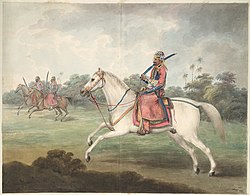First Rohilla War
| The First Rohilla War | |||||||||
|---|---|---|---|---|---|---|---|---|---|
| Part of Rohilla Wars | |||||||||
 Rohilla Cavalry | |||||||||
| |||||||||
| Belligerents | |||||||||
|
| |||||||||
| Commanders and leaders | |||||||||
|
|
| ||||||||
The First Rohilla War of 1773–1774 was a punitive campaign by Shuja-ud-Daula, Nawab of Awadh on the behalf of Mughal Emperor, against the Rohillas, Afghan highlanders settled in Rohilkhand, northern India. The Nawab was supported by troops of the British East India Company, in a successful campaign brought about by the Rohillas reneging on a debt to the Nawab.
Background[edit]
Having been driven into the mountains by the Marathas, a few years earlier, the Rohillas had appealed for aid to Shuja-ud-Daulah, at that time an ally of the British. The Nawab demanded in return 40 rods of gold, that Rohilla chiefs refused to pay. The Nawab then decided to annex their country, and appealed to Warren Hastings for assistance, which was given in return for a sum of forty lakhs of rupees.[1]
Hastings justified his action on the ground that the Rohillas were a danger to the British as uncovering the flank of Awadh.[1]
Course of the war[edit]
The Rohillas under Hafiz Rahmat Ali Khan[2] were defeated by Colonel Alexander Champion on 23 April 1774 at the Battle of Miranpur Katra. The decisive battle, in which Hafiz Rahmat Khan died, caused the Rohillas to flee to the mountains near Loll Dong.[3]
Guerrilla War and Siege[edit]
By October 1774, the war evolved into a war of attrition. Faizullah Khan with the remaining loyal Rohillas retreated to a forest located in the hills of Lal Dang. The combined forces of the British and Awadh laid siege to the area from late August 1774 to October of the same year. Both sides were worn down and wished for peace.
Shah Shuja, who was suffering from cancer in his leg, wanted an early peace and thus after several attempts to break Rohilla unity under Faizullah Khan, he finally decided to release Mohabbat Khan, son of the late Hafiz Rehmat Khan in an attempt to undermine Faizullah's authority while at the same time he kept communication with Faizullah. His strategy worked and on 7 October 1774 Faizullah signed an amicable treaty of Lal dang and was granted a princely state in the area of his choosing, leading to the creation of Rampur State.[4]
Consequences[edit]
Rohilkhand fell to Awadh, was plundered and occupied. The majority of the Rohillas left. They fled across the Ganges in numbers, to start a guerrilla war; or emigrated. A Rohilla state under British protection was set up in Rampur. Faizullah Khan managed to become the nawab of newly created Rampur state. After his death his son Muhammad Ali Khan succeeded him who was deposed by his younger brother and second son of Faizullah Khan named Ghulam Muhammad Khan Bahadur.The aspirations of Afghan Rohillas under him led him to participate in the Second Rohilla War, in 1794.The primary intention was to regain the erstwhile territories of Rohillas.[5]
However, Ghulam Muhammad's accession to the throne by leading a conspiracy against his brother was not liked by Britishers, who derecognised him as ruler of the Rampur state. Large number of Afghans then flocked to join him against the British but ultimately he was defeated and the state which was now considerably reduced in size was handed over to the infant son of Muhammad Ali Khan.[5]
Warren Hastings[edit]
The war became a matter of Westminster politics during the Impeachment of Warren Hastings. Charges of destroying a nation were brought against Hastings by Edmund Burke and later Thomas Macaulay.[1]
References[edit]
- John Strachey (1892), Hastings and the Rohilla War
Notes[edit]
- ↑ 1.0 1.1 1.2
 One or more of the preceding sentences incorporates text from a publication now in the public domain: Chisholm, Hugh, ed. (1911). "Rohilla". Encyclopædia Britannica. Vol. 23 (11th ed.). Cambridge University Press. p. 461.
One or more of the preceding sentences incorporates text from a publication now in the public domain: Chisholm, Hugh, ed. (1911). "Rohilla". Encyclopædia Britannica. Vol. 23 (11th ed.). Cambridge University Press. p. 461.
- ↑ Introduction to the Eleven Illustrations of Ghulam Yahya
- ↑ Miranpur Katra in India
- ↑ Prasad, Alok (2012). "Rohilla Resistance Against Colonial Intervention Under Nawab Faizullah Khan of Rampur (1774-1794)". Proceedings of the Indian History Congress. 73: 563–572. JSTOR 44156249.
- ↑ 5.0 5.1 Strachey, John (1892). Hastings and the Rohilla war. Clarendon Press. pp. 280–281. OCLC 1045958597. Retrieved 27 August 2019.